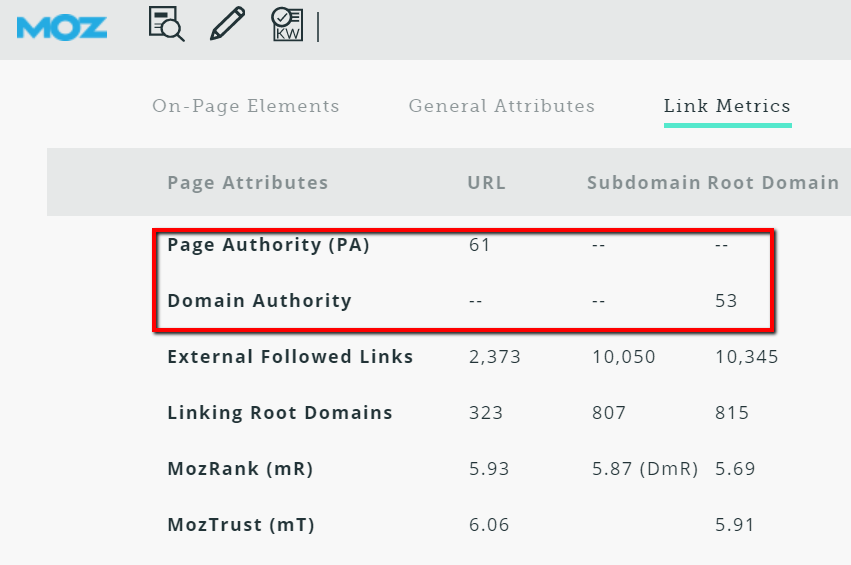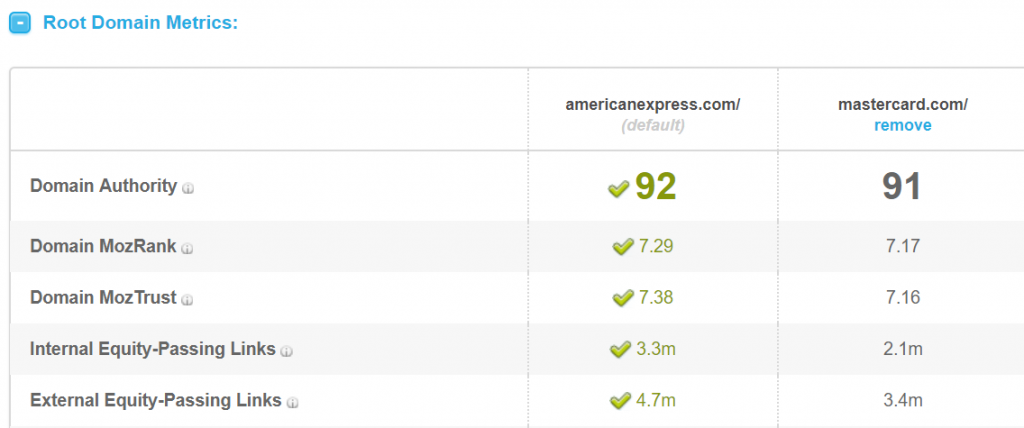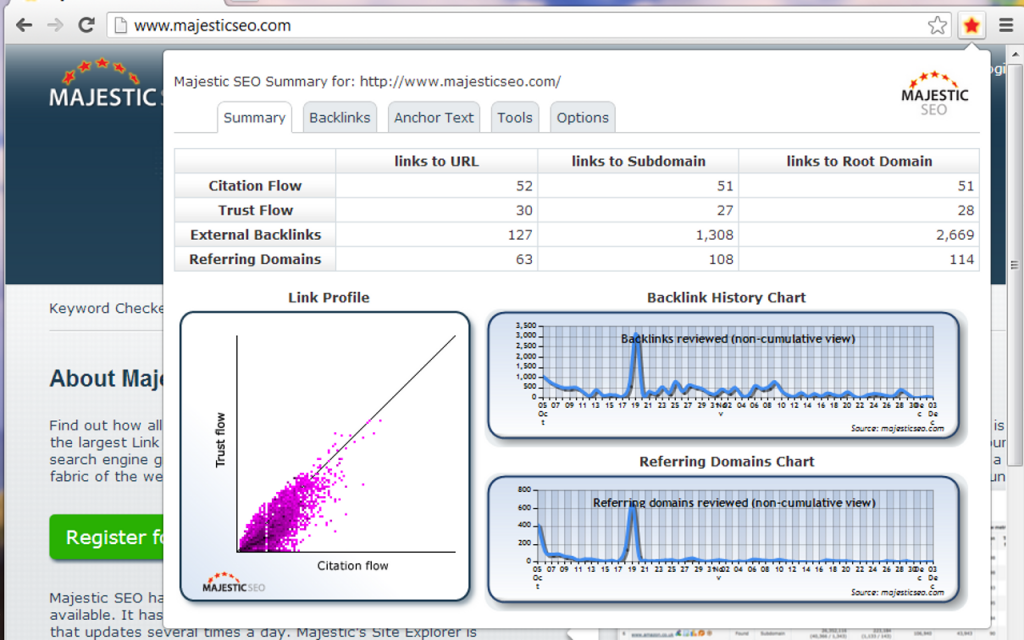Domain Authority (DA) is a metric that serves as a handy heuristic in the SEO industry. Put simply, it provides insight into how likely a site is to rank for specific keywords, based on the SEO authority it holds. There are numerous tools that can help us arrive at these useful scores.
Below, we round up some of the most accurate and intuitive ways to see a site’s SEO equity.
In an often opaque industry, with few insights into how Google’s algorithms really work for organic search, the lure of a metric like Domain Authority is self-evident.
It provides a glimpse into the SEO “strength” of a website, in a similar fashion to the now obsolete PageRank toolbar. Google still makes use of some variation of the PR algorithm internally, but its scores are no longer visible to the public and were never particularly helpful.
If anything, they encouraged some negative attempts to “game” Google’s rankings through link acquisition.
However, many SEOs make use of Domain Authority to sense-check the quality of their inbound links and to understand how these are affecting their own’s site’s SEO health.
What is Domain Authority?
“Domain Authority (DA) is a search engine ranking score developed by Moz that predicts how well a website will rank on search engine result pages (SERPs). A Domain Authority score ranges from one to 100, with higher scores corresponding to a greater ability to rank.
Domain Authority is calculated by evaluating linking root domains, number of total links, MozRank, MozTrust, etc. — into a single DA score. This score can then be used when comparing websites or tracking the “ranking strength” of a website over time.” – Moz.
Ultimately, this is a representative model of how Google decides which pages should rank for each query, and in what order they should rank.
As is the case with the term ‘relevance’, authority covers a very broad area of assessment that is open to interpretation. Domain Authority aims to cut through that ambiguity by providing a metric that can compare the SEO strength of different websites based on a consistent methodology.
Although marketers are aware that DA has intrinsic limitations as a metric, it is at least a barometer of whether our SEO efforts are gaining traction or not. As such, it serves an important purpose.
When prospecting for new links, for example, it is helpful to check the DA of external sites before contacting the site about a potential partnership. Combined with a range of other metrics – both qualitative and quantitative – Domain Authority can therefore guide brands towards more effective SEO decisions.
‘Domain Authority’ was devised by Moz and they have naturally taken ownership of this name. Their suite of tools (some of which are discussed in this article) will reveal the authority of particular domains, but dozens of other free tools use Moz’s API to show these scores too.
However, a couple of other SEO software packages provide a slightly different view on a domain’s SEO strength.
Moz’s scores are based on the links contained within its own index, which is undoubtedly smaller than Google’s index of URLs.
Other SEO software companies, such as Majestic and Ahrefs, have their own index of URLs. These indexes will largely overlap with each other, but there are still questions to pose to your chosen provider:
- Index size: How many URLs are contained within the software’s index?
- Frequency of index crawling: How often is the index refreshed?
- Live links: Are there common instances of ‘false positives’, where inactive links are reported with 200 status codes?
- Correlation with actual rankings: Simply, does a higher domain score equate to better rankings?
The importance of these questions, and the resultant significance of their answers, will depend on a brand’s context. Nonetheless, these are points worth considering when assessing the scores your site receives.
Each of the main players in this space has subtle distinctions within its methodology, which will be important for most SEOs.
We will begin our round-up with the Moz tools (some of them free) that will show the Domain Authority for any site, before looking at a couple of alternatives that provide a valuable reference point.
Moz (MozBar, Open Site Explorer)
It should be clear that Moz is the major contender when it comes to checking a domain’s SEO authority. We included MozBar on our list of the best Google Chrome extensions for SEO and it deserves its place in this list, too.
MozBar will highlight the Domain Authority of any site a user is browsing, along with the Page Authority (PA) of that particular URL. As the name suggest, PA applies a similar methodology to DA, but localized to a particular URL rather than a domain.

This is also available in search results pages, making it possible to see whether a site’s Domain or Page Authority correlates with higher rankings for particular queries.
As such, these two metrics in combination are a great starting point for investigations into the quality and quantity of backlinks pointing to a domain.
Marketers should be aware, however, that these scores do fluctuate.
That should be viewed as a positive, as the scores are an increasingly accurate reflection of how Google is evaluating sites. Moz employs machine learning algorithms to re-calibrate the authority scores based on link activity across its index, but also the impact that certain types of link have.
We can consider this an attempt to peg the Moz index to that of Google, and we know the latter is tweaked thousands of times a year.
Therefore, we should be careful about the causal links we infer from DA scores.
When tracking Domain Authority, always benchmark against similar sites to avoid viewing this as an absolute indication of how well you are performing. By viewing it as a relative metric instead, we can gain a healthier insight into whether our strategy is working.
This is where another Moz-owned tool, Open Site Explorer, proves its worth. Open Site Explorer uses a range of proprietary Moz metrics to highlight the areas in which specific sites under- or over-perform. the side by side comparisons it creates are an intuitive way to spot strengths and weaknesses in a site’s link profile on a broader scale.

Moz’s Domain Authority is undoubtedly useful – especially when used as an entry point into deeper investigation. MozBar and Open Site Explorer provide access to this metric for all marketers, so they should be viewed as the go-to resources for anyone seeking a check on their site’s SEO ranking potential.
Ahrefs
Ahrefs boasts an index of over 12 trillion links and data on 200 million root domains, making it an invaluable repository for SEOs wanting to understand their site’s SEO performance.
The two metrics that matter within the scope of this article are URL Rating (UR) and Domain Rating (DR).
We can consider these Ahrefs’ equivalents to Page Authority and Domain Authority, respectively, at least in terms of their purpose.
The latter is defined by Ahrefs as “a proprietary metric that shows the strength of a target website’s total backlink profile (in terms of its size and quality).”
It appears frequently within the software interface, in examples like the one in the screenshot below:

So, why would you use the Ahrefs DR score over Moz’s DA calculation? Their definitions do seem strikingly similar, after all.
As always, the detail is critical. If we refer back to our initial points for consideration, it becomes possible to compare Ahrefs with Moz:
- Index size
- Frequency of index crawling
- Live links
- Correlation with actual rankings
Both Moz and Ahrefs have invested significantly in improving the size, quality and freshness of their link data. Some SEOs have a preference for one over the other, and their scores do vary significantly on occasion.
Those that prefer Ahrefs typically do so for the freshness of its index and DR’s correlation with actual rankings.
The clarity of the Ahrefs methodology is also very welcome, right down to the number of links typically required to reach a specific DR score.
To put things simply, we calculate the DR of a given website the following way:
- Look at how many unique domains have at least 1 dofollow link to the target website;
- Take into account the DR values of those linking domains;
- Take into account how many unique domains each of those websites link to;
- Apply some math and coding magic to calculate “raw” DR scores;
- Plot these scores on a 0–100 scale (which is dynamic in nature and will “stretch” over time).
- DR 0–20: 20 ref.domains
- DR 20–40: 603 ref.domains
- DR 40–60: 4,212 ref.domains
- DR 60–80: 25,638 ref.domains
- DR 80–100: 335,717 ref.domains
Ahrefs requires a monthly licence to access its data; for those that do sign up, it provides a very useful sanity check for the domain strength scores seen elsewhere.
Majestic
Majestic is marketed as “The planet’s largest link index database” and it remains a trusted component of any SEO toolbox for the thorough nature of its backlink data.
Offering two index options (Fresh and Historic), it also allows marketers to different views of how their domain is performing. As with Moz and Ahrefs, Majestic’s scores for site strength are calculated almost exclusively based on the quality and quantity of inbound links.
Opting for the Historic Index will see Majestic scour the billions of URLs it has crawled within the last 5 years, while the Fresh Index is updated multiple times per day.
This software takes a slightly different tack in relation to the labeling of its domain metrics, which are known as Trust Flow and Citation Flow.

These are interrelated metrics that combine to form the set of Majestic Flow Metrics. These are very insightful because of the immediate score they provide (ranging from a low of 0 to a high of 100), and also for the opportunities to dig further into the backlink data.
One favorite feature of Majestic is the ability to analyze historical backlink acquisition trends, both in terms of links gained and links lost. As such, Majestic’s domain strength metrics provide actionable insight that can be used to shape strategy immediately. For example, the loss of a lot of links on a particular date may provide an opportunity to reach out to webmasters and try to regain that equity.
Majestic also comes with a handy toolbar that overlays domain metrics on the site a user is browsing. Although an apples to apples comparison between Majestic and Moz or Majestic and Ahrefs, in relation to the efficacy of their domain authority rankings, would be difficult, this would also be to miss the point.
All of these tools are aiming to mimic the functioning of Google as accurately as they can; taken together they form a more rounded picture.
In summary
Given the ongoing significance not only of backlinks, but also the potential of unlinked mentions to boost performance, search marketers are quite rightly looking to Domain Authority to assess their SEO potential.
The core elements of a successful, customer-centric remain the same as they always were; higher scores, from whichever domain metrics one chooses to monitor, should be seen as a natural by-product of a strategy that fulfils the modern consumer’s needs.
source https://searchenginewatch.com/2018/02/09/how-to-check-your-domain-authority-4-tools-to-use/
No comments:
Post a Comment